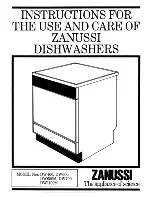
Operating instructions FV 28 GiO
Datei:1D3A4F9D.doc
9671086
20/38
W e reserv e the right to change ex ecution and construction!
MEIKO Maschinenbau GmbH & Co. KG, Englerstr. 3, D-77652 Offenburg, Tel.: +49/781/203-0, Fax: +49/781/203-1121
11.1.3 Detergent dosage
The detergent dosing unit is designed for the automatic addition of liquid alkaline deter-
gent to the clean water.
The detergent is transported out of the container into the clean tank by means of a hose
line. The dosing unit is self-priming. The dosing is effected during each filling cycle and at
the beginning of each programme cycle using timer control.
Normally, a dosing of approx. 2 ml of detergent per liter of tank water is the correct
concentration. This can be increased/reduced acc. to the water quality, items to be
washed and degree of soiling to 5 ml/l or to1 ml/l.
Please observe dosing's instructions of manufacture's detergent!
11.1.4 Rinse aid dosing
The rinse aid dosing unit is designed to automatically add liquid final rinse aid into the
fresh water.
The rinse aid is transported out of the container into the fresh water supply line by means
of a hose line. The dosing unit is self-priming. The dosing takes place during each filling
cycle using timer control.
The correct dosing results in a smooth, even water film. In case of overdosing, there
are bubble and stripe formations - reduce dosing. In case of under-dosing, water drops
remain on the washed items - increase dosing.
11.2 Noise level
Work place noise level LpA
70 dB
11.3 Data reg. the electrical and hydraulic equipment
See attached technical sheet
11.4 Dimensions, technical data, installation instructions
See enclosed documentation papers.
12
Non-ionizing radiation
Non-ionizing radiation is not produced intentionally but unfortunately comes about due to
electrical operating equipment (e.g. electrical motors, high-voltage cables and magnetic
coils). In addition the machine has no strong permanent magnet. There is a high possibil-
ity of eliminating the influence of active implants (e.g. pacers, defibrillators) by maintaining
a safety distance of 30 cm (distance of the field source to the implant).
















































